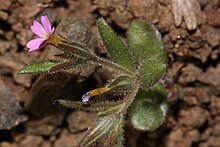| Microsteris | |
|---|---|

| |
| Scientific classification | |
| Kingdom: | Plantae |
| Clade: | Tracheophytes |
| Clade: | Angiosperms |
| Clade: | Eudicots |
| Clade: | Asterids |
| Order: | Ericales |
| Family: | Polemoniaceae |
| Genus: | Microsteris Greene (1898) |
| Species: | M. gracilis |
| Binomial name | |
| Microsteris gracilis (Hook.) Greene (1898) | |
| Varieties | |
| |
| Synonyms | |
| |
Microsteris is a monotypic genus of flowering plants in the phlox family containing the single species Microsteris gracilis, known by the common name slender phlox.
The segregation of this species into a genus of its own is controversial, and many botanists continue to include the plant in genus Phlox. Genetic analysis is continuing.
Distribution
Microsteris gracilis is native to western North America from northwestern Canada to the American Midwest and West Coast, through Mexico, as well as parts of South America. It is native to all the diverse plant communities in California.

Description
Microsteris gracilis is an annual herb which is variable in shape, taking a decumbent, branching, sometimes almost tuftlike form or growing erect and very slender. Its maximum height approaches 20 centimeters, but it may be much smaller.
The lance-shaped leaves are 1 to 3 centimeters long and oppositely arranged except for the upper ones, which are alternate. The herbage is glandular and hairy in texture. The inflorescence at the top of the stem bears one or more small flowers.
The flower has a tubular throat around a centimeter long encased in a tubular calyx of sepals. The flat corolla has five flat-tipped or notched lobes just 1 or 2 millimeters long. The flower is white to bright pink with a yellowish throat.
References
- ^ Microsteris gracilis (Hook.) Greene. Plants of the World Online. Retrieved 19 April 2024.
- Prather, L. A., C. J. Ferguson, and R. K. Jansen. (2000). Polemoniaceae phylogeny and classification: implications of sequence data from the chloroplast gene ndhF. American Journal of Botany 87 1300-08.
- Ferguson, C. J. and R. K. Jansen. (2002). A chloroplast DNA phylogeny of eastern Phlox (Polemoniaceae): implications of congruence and incongruence with the ITS phylogeny. American Journal of Botany 89 1324-35.
- Jepson eFlora: Distribution map for Microsteris gracilis in California
External links
- Jepson Manual Treatment of Microsteris gracilis
- USDA Plants Profile for Microsteris gracilis (slender phlox)
- Microsteris gracilis — U.C. Photo gallery
| Taxon identifiers | |
|---|---|
| Microsteris gracilis |
|
| Gilia gracilis | |
- Monotypic Ericales genera
- Polemoniaceae
- Flora of Mexico
- Flora of Western Canada
- Flora of the Northwestern United States
- Flora of the Southwestern United States
- Flora of California
- Flora of Nebraska
- Flora of South Dakota
- Flora of Southern America
- Flora of the California desert regions
- Flora of the Cascade Range
- Flora of the Great Basin
- Flora of the Klamath Mountains
- Flora of the Sierra Nevada (United States)
- Natural history of the California chaparral and woodlands
- Natural history of the California Coast Ranges
- Natural history of the Peninsular Ranges
- Natural history of the Transverse Ranges
- Polemoniaceae genera
- Plants described in 1829
- Taxa named by William Jackson Hooker